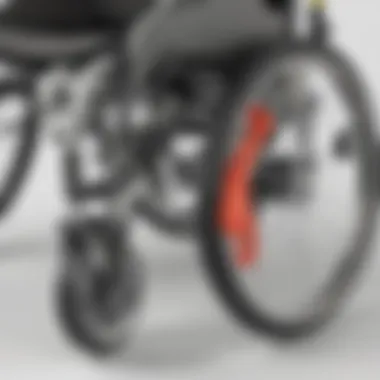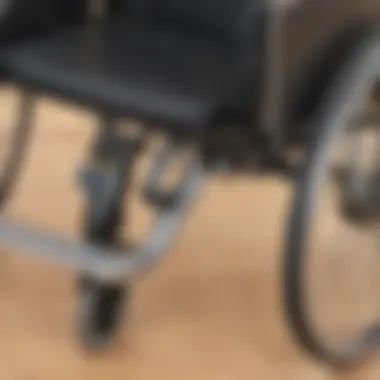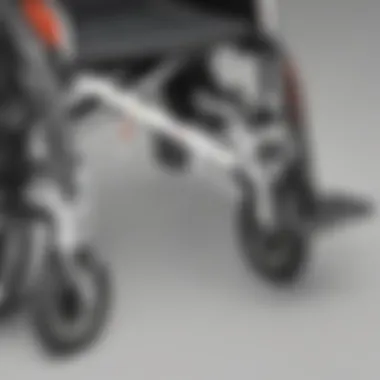DIY Wheelchair Handle Extenders: Enhance Mobility & Comfort


Intro
The necessity for improved mobility and access has long been a subject of discussion in the realm of disability support. Wheelchair users often face challenges that can impede their independence and comfort. One such challenge is the height and leverage of the wheelchair handles.
DIY wheelchair handle extenders provide an innovative solution. These extenders allow users to personalize their wheelchairs, adapting them to specific needs for easier maneuverability. The tasks of handling day-to-day challenges become less taxing, fostering an overall notion of autonomy while enhancing the wheelchair experience.
In the following sections, we will explore the various components of creating your own wheelchair handle extenders. From the materials used to safety considerations, we shall provide a comprehensive guide that deepens understanding for both DIY enthusiasts and those who might simply be looking for better ways to improve mobility and accessibility.
Understanding the Need for Handle Extenders
Users of wheelchairs often have to strain their physiques to grip the handles, especially if the wheelchair’s design doesn’t suit them. By raising the handle positions, individuals can access greater comfort and ease. Better handle height directly leads to enhanced control over navigation including turns, stops, and overall maneuvering.
Benefits of Customizing Wheelchair Handles
- Improved Maneuverability: Taller handles can alleviate strain on a user's upper body.
- Increased Comfort: Adjusted grips can accommodate various postures and sitting levels.
- Personalization: Creating a custom setup allows individuals to adapt their wheelchairs to match their unique circumstances.
- Cost-Effective: DIY solutions are generally lower in cost compared to commercial products.
Selecting Materials for Handle Extenders
When constructng wheelchair handle extenders, it's crucial to choose the right materials. The durability and functionality hinge on this choice. Suitable materials can include:
- PVC Pipe: Lightweight as well as easily adjustable.
- Aluminum Tubing: Offers strength without excess weight.
- Wood: Possible for a more traditional approach, yet requires proper sealing for longevity.
Considerations in Material Choice
- *Weight Limit: Ensure every component can handle the strains of regular use.
- Grip Texture: Smooth materials can be slippery; consider options that promote better gripping.
- Sturdiness: Select materials that can withstand dynamic movement to avoid hazardous incidents.
Step-by-Step Guide for Creating Handle Extenders
The following steps serve as a guideline for anyone interested in this project. While each wheelchair presents its challenges, the fundamental construction remains consistent.
- Measure the current handle height properly relative to the user’s comfort level.
- Choose required materials, ensuring they meet all outlined criteria.
- Cut materials to obtain desired length according to the measurements you noted.
- Assemble the extension pieces securely, ensuring they fit naturally with the existing handles.
- Attach the extenders to the wheelchair accurately to avoid misalignment.
- Test the handles for stability under pressure before regular use.
"The use of DIY handle extenders not merely enhances functionality, it symbolizes empowerment for those who craft them."
Safety Considerations
When working on any DIY project, safety should be top priority. Below are critical considerations:
- Secure Installation: Confirm that all attachments hold firm to prevent slips during attempts to navigate.
- User Weight and Load: Recognize the load limit that each extension can consistently handle.
- Regular Checks: Periodically reassess the condition of extenders and relock any loose components.
Lastly, the modifications should align with specific wheelchair models. Always check manufacturer guidelines for required specifications.
Understanding Wheelchair Handle Extenders
Definition and Purpose
Wheelchair handle extenders are devices designed to improve the steering efficiency and overall ease of navigating a wheelchair. Their primary purpose is to elongate the standard handles mounted on a wheelchair, allowing a user or caregiver greater distance when maneuvering. This setup enhances the ability to navigate even tight spaces, providing significant advantages in accessibility. As wheelchairs come in various types and sizes, the relevance of this customization cannot be overstated. Each design serves to aid in comfort, control, and maneuverability throughout different environments.
Importance of Personalization
Personalizing wheelchair handles is essential in tailoring the mobility experience for individual users. Each person's height, strength, and pulling or pushing capabilities differ. Hence, handle extenders become vital in addressing these personal characteristics. These connectors not only help in the physical handling of the wheelchair but also contribute to the autonomy and confidence of users as they get a sense of control during their mobility. Moreover, a personalized fit reduces strain on the back and arms, a particularly beneficial aspect for caregivers who move the chair for others often.
Personalization significantly improves not just the functionality of mobility aids, but also the user's experience and independence.
Additionally, customizing wheelchair handle extenders can lead to various innovative solutions that reflect personal style and practical needs. Ultimately, improved ergonomics that come with well-outfitted handle extenders can heavily impact a user’s daily quality of life.
Assessing the Need for Handle Extenders
Evaluating the necessity for handle extenders is a crucial step in optimizing wheelchair use for individuals. This assessment directly affects the comfort, control, and overall experience of wheelchair users. Analytics from user experiences reveal significant advantages for those who choose to personalize their handles. Not every user will require the same modifications, so this section emphasizes a systematic approach to understanding specific user needs.


Evaluating User Requirements
When considering handle extenders, one must begin with a thorough evaluation of the user's unique requirements. Here are some essential factors to contemplate:
- Height Consideration: The user’s height can greatly influence their grasp of the handles. Extenders may be needed to prevent excessive bending or stretching, which may impair mobility.
- Grip Comfort: Assessing how hands fit around the current handles is vital. Comfort while gripping relates directly to effective maneuverability.
- Functional Purpose: What primary functions does the user expect? If navigating narrow spaces is frequent, longer extenders may assist.
User evaluation can go beyond mere measurements. Communicate directly with the user for insights into their experiences. This dialogue can help in identifying difficulties or requests for improvement with the current setup.
Identifying Maneuverability Challenges
Maneuverability relies on many factors that contribute to the effectiveness of control while using a wheelchair. Identifying these challenges ensures an appropriate inflection in design or extension. Here are several key challenges:
- Turning Radius: Many built environments have tight turns.A wheelchair should navigate these easily without the user needing to lean excessively or struggle for control.
- Stability Concerns: Handling becomes difficult if extenders shift balance away; stability should remain steady. Issues with tipping may arise within specific terrains or inclines.
- Environmental Navigation: Users may face obstacles based on outdoor conditions like uneven pathways, which calls for awareness on contributing factors that affect wheelchair travel.
Properly identifying these challenges enables the design of more ergonomic handle extenders. The goal is to enrich the mobility experience profoundly. Addressing these factors leads to better customization and ultimately enables a successful implementation of handle extenders, empowering users as they navigate their surroundings with confidence.
Materials for DIY Handle Extenders
Understanding the right materials for creating wheelchair handle extenders is crucial. The selection impacts functionality, durability, and user safety. Choosing suitable materials is not just about availability; it also involves considering the end-user experience. This section will outline common materials one may use and how to select materials that ensure durability and safety.
Common Materials Used
When designing handle extenders, common materials include the following:
- Aluminum: Lightweight and resistant to corrosion, aluminum is often chosen for its strength and ease of shaping.
- Plastic: Lightweight and often less expensive, plastic can provide suitable grip and comfort; however, its longevity is less than process and metals.
- Steel: Steel offers durability and strength but is relatively heavier. It is useful where support tension is necessary.
- Wood: Though not as common, wood can be aesthetic and provide good grip yet needs careful treatment against wear and tear.
Each of these materials offers distinct advantages and settings where it is most effective. The user's weight, type of wheelchair, and user-specific needs must also factor into material choice.
Choosing Durable and Safe Materials
Selecting durable and safe materials is a key consideration when designing DIY wheelchair handle extenders. Look for the following features:
- Resistance to Wear: Materials should resist scratches, dents, and deformation over time.
- Weight Capacity: Ensure the materials can support the user's weight without losing integrity.
- Non-slip Surfaces: Grippy finishes can provide safer handling.
- Toxicity: Especially for plastic, confirming it is free from harmful chemicals is paramount.
Choosing the right materials lays the foundation for a stable and efficient use of wheelchair handle extenders, greatly enhancing the mobility experience.
When evaluating materials, consider how they work collectively with the wheelchair’s existing build. Prioritizing safety and usability will lead to more effective extenders, ultimately achieving smoother navigation for the user.
Tools Required for Construction
Understanding the necessary tools for constructing wheelchair handle extenders plays a pivotal role in ensuring the process is efficient, safe, and successful. With the right tools, users can craft functional and reliable extensions that enhance mobility significantly. Assembling the appropriate tools not only aids in proper assembly but also results in a more satisfying, effective DIY experience. In simplher terms, it can be the difference between a well-constructed solution and an abject failure.
Essential Tools Overview
When looking to build wheelchair handle extenders, there are several essential tools required. Understanding each tool's purpose enhances your proficiency and serves the end goal effectively:
- Measuring Tape: Accurate measurements are crucial. A measuring tape aids in obtaining the correct dimensions for handle extenders, ensuring they fit precisely.
- Saw: A good quality saw, whether hand or power, is necessary for cutting the materials to the desired lengths.
- Drill: This tool makes creating holes easy, allowing secure attachment points for assembling parts together.
- Screwdriver Set: It’s important to have a set that supports both Philips and flathead screws, which securing various joints and fixtures needs.
- Sandpaper or File: Post cutting and drilling, materials may have sharp edges. Sandpaper or files smooth these surfaces, ensuring user safety.
By having these tools on hand, you can proceed with confidence into the subsequent steps of the building process.
Safety Equipment Recommendations
Prioritizing safety while working with various tools is indispensable. Using the right safety equipment minimizes risks that can arise during the DIY process. Here are some essential safety items to consider:
- Safety Goggles: Protects your eyes from debris that may occur during sawing or drilling.
- Gloves: A good pair of gloves provides protection against cuts and scrapes when handling tools and materials. Select ones that offer both dexterity and robustness.
- Dust Mask: When sanding or using power tools, a dust mask helps to protect your lungs from any airborne particles.
Using proper safety Equipment not only fosters environment conducive to safe working but also cultivates a mindset focused on well-being through diligence.
Remember, safety is not merely an ancillary thought; it is a fundamental principle during any DIY endeavor. Failures in safety attention can lead to serious and avoidable accidents.
Step-by-Step Guide to Building Handle Extenders


Building wheelchair handle extenders is a meaningful process that can greatly improve the maneuverability of a wheelchair. A step-by-step guide helps simplify tasks, ensuring accuracy and enhancing the usability of the final product. Following clear steps ensures that individuals, particularly those new to DIY projects, can effectively create solutions tailored to their needs. Moreover, each phase contributes to overall safety, stability, and functionality.
Planning and Measurement
Careful planning is crucial before any building starts. Determine the needed length and style of the handle extenders based on the user’s preferences. Measuring accurately with a tape measure allows for adjustments.”
- Determine the Length: Decide how much extension is necessary for safe handling. For most users, having the handle about 4-6 inches higher than the original is a good starting point.
- Unsuitable Dimensions: Avoid arbitrary lengths; improper measurements may lead to discomfort or accidents.
- Sketch a Diagram: Create a simple sketch indicating where the handle extenders will fit to visualize how they’ll help.
Taking these steps significantly impacts the ease of use.
Cutting and Shaping Materials
Using the right materials completes the process. Various materials like PVC or aluminum can be utilized. After choosing, prepare for cutting and shaping:
- Gather Tools: Ensure you have a saw, sandpaper, and files ready for shaping. Use a pipe cutter or hacksaw to cut materials cleanly.
- Safety First: Always wear safety glasses and gloves while cutting materials.
- Shape Edges: Smooth the cut edges using sandpaper or a file to avoid sharp parts that can cause injury.
This careful shaping can prevent future accidents and ensure user comfort.
Assembling the Handle Extenders
Next comes the assembly phase. Proper assembly is essential for functionality. The following steps are important:
- Secure Components: Use epoxy, screws, or brackets to connect manufactured parts. It’s wise to double-check that all pieces fit snugly.
- Ensure Alignment: Keep each extender aligned with the wheelchair’s existing handles to avoid wobbling.
- Tighten Parts: Re-check all connections for security. Bend tests and every physical movement can help reveal weakness in connections before worrying about praise.
Following these steps yields functional and safe extenders.
Finishing Touches and Testing
Final tweaks can make a big difference in overall performance. Decide on the aesthetic appeal like grips or padding:
- Test Simulations: Do gravity tests with weights to verify if they can handle pressure without damage.
- Try Real applications: Use the wheelchair to simulate real-life movements ensuring turning, stopping, and accelerating works effectively.
- Edit If Critical: If feedback highlights areas needing modification in size or placement, observe any potential adjustments carefully.
Testing is a vital process to confirm that your efforts have resulted in a reliable and sturdy product. Ultimately, a solid and enjoyable user experience validates all prior work completed in the owner’s right.
Testing and Installing Handle Extenders
Testing and installing handle extenders are crucial steps in ensuring that the modifications enhance the usability of a wheelchair. Adjustments that increase mobility without compromising safety are paramount for wheelchair users. A successful installation means avoiding common pitfalls and realizing the extenders’ true potential.
Securing the Extenders on the Wheelchair
Once the handle extenders are built, securely attaching them to the wheelchair is next. Begin by aligning the extenders with the existing handles. Ensure a tight fit without forcing them in place, as this may cause damage. Using appropriate clamps or bolts is essential. Here are straightforward steps to follow:
- Cleaning the Surface: Remove any dirt or residue where the extenders will attach.
- Aligning the Parts: Make sure everything fits well and sits firmly.
- Using Fasteners: Bolts or heavy-duty zip ties can be effective.
- Double-Checking Security: Shake gently to ensure stability. Tighten where necessary.
An effective securement guarantees both safety and reliability, providing confidence while navigating various terrains.
Performing Functionality Tests
After installation, testing functionality becomes paramount. Users need to see that these extensions serve their intended purpose. It’s advisable to assess several factors:
- Stability: Check if the extenders can handle user weight and impacts while turning.
- Ease of Use: Ensure that the height adjustment allows for comfortable steering.
- Maneuverability: Navigate the wheelchair through narrow spaces to tag any ergonomic issues.
- User Feedback: It is critical to speak with the user after the tests. There may be adjustments needed based on personal comfort and ease of use.
It's wise to begin testing in familiar environments before moving into more challenging spaces. Documenting findings during this process is beneficial to make informed adjustments.
Testing and securing correctly can greatly enhance safety, ensuring that DIY efforts lead to meaningful improvements in mobility and accessibility for wheelchair users.
Checking functionality cannot be rushed. Taking the time to ensure the handle extenders work effectively contributes to the overall positive impact of the modification on the user's daily life.
Safety Considerations in Using Handle Extenders
When modifying a wheelchair with handle extenders, safety is a crucial aspect that should not be overlooked. The consequences of improper usage or installation of these extenders can range from minor inconveniences to serious accidents. Proper forethought and precautions are vital to ensure that users can navigate their environment safely and effectively. Understanding the physics involved, along with common pitfalls in custom builds, can significantly enhance the user experience.


Understanding Weight Distribution
One key factor that affects safety in the planning stages is weight distribution. Wheelchairs are designed with a specific weight limit, ensuring stability and control. When handle extenders are added, they can shift the center of gravity. This shift may cause stability issues during sudden movements or turns.
It is essential to ensure that the extender does not add excessive weight or create unbalanced forces. Here are some important points to consider:
- Weight Limit: Always take note of the wheelchair’s weight limit. Make sure that the combined weight of the user and any attached devices does not exceed this limit.
- Material Choice: Select lightweight but durable materials for the extenders. Options like aluminum can provide effectiveness without weighing down the wheelchair.
- Even Spacing: When installing the extenders, ensure they are evenly spaced on both sides. This prevents uneven weight shifting during use.
Following these guidelines ensures a smooth ride and minimizes risks associated with sudden movements.
Avoiding Common Mistakes
In the DIY process, avoiding certain mistakes is paramount for safety and functionality. Following are crucial blunders that can compromise the integrity of wheelchair handle extenders:
- Ignoring Measurements: Precise measurements are necessary when creating extenders. Measure twice before cutting. Improper dimensions can create excess play in the handling, leading to decreased control.
- Using Inadequate Fasteners: Ensure the choices of fasteners are sufficiently strong to hold the extenders securely. Unsafe materials can lead to come loose and katkavitate accidents when the user needs dependability the most.
- Neglecting Regular Checks: After installation, it is a good idea to regularly check for signs of wear and tear. Fractured, unsecure, or worn out materials can become dangerous over time.
- Looping or Snagging Hazard: Ensure that there are no hanging parts that could snag on clothing or obstacles. Smooth, clean lines provide not just comfort but a safe operation.
By proceeding with caution and mindfulness during the customization process, users can enjoy improvements in transition smoothly and with strong confidence.
Ultimately, remaining aware of these safety considerations when using handle extenders can have a profound effect on user experience. Creating additional confidence through detailed, carefully planned ventures makes propulsion not just easier, but safer.
Potential Modifications for Different Wheelchair Models
Recognizing the distinctiveness between different wheelchair models is crucial in the pursuit of effective DIY handle extenders. The necessity for potential modifications arises principally from the variable designs, configurations, and user needs that different models present. Acknowledging these differences allows for enhancements that ensure adaptability, functionality, and comfort. These modifications lead to better user experience, ultimately improving mobility.
Identifying Wheelchair Types
Wheelchairs come in various types, each with unique specifications intended for diverse user requirements. Understanding these variations can influence the design and installation process for handle extenders significantly. Common types of wheelchairs include:
- Manual Wheelchairs: Operated by the user or an attendant, these often need handle extenders positioned for ease of pushing.
- Electric Wheelchairs: Featuring electric propulsion mechanisms, handle extenders may require additional stabilization to handle motorized movement.
- Standing Wheelchairs: Users can adjust their position, while the handle extenders should support varying heights.
- Children’s Wheelchairs: Smaller structures require specially customized handle extenders to accommodate shorter pushes and movements.
Evaluating these aspects can serve as a foundation for modifications. The focus can be directed towards aspects such as weight distribution, ease of adjustment, and operational dynamics specific to each type of wheelchair.
Adapting Designs for Specific Models
Each wheelchair model may necessitate tailored design strategies for the creation of handle extenders. Often, design adaptation hinges on the mechanics of the wheelchair framework. Consider the following elements for adapting handle extenders effectively:
- Frame Compatibility: Handle extenders must be adjusted or shaped to integrate perfectly with given wheelchair frame dimensions.
- Attachment Mechanisms: Recognizing how extenders will attach to the main handle can affect stability. Designs like clamps or direct bolts are common.
- Height Adjustability: Having range in the height of extenders allows users to modify their positions based on comfort. Extenders for children may find need to be adjustable as they grow.
- User Feedback: An iterative approach by involving users in the testing can provide valuable insights for necessary changes or additions.
Through attention to details specific to each model, users can ensure their handle extenders address their particular Challenges directly, fostering a more responsive wheelchair experience.
Remember: Tailored adaptations to designs consider both practical functionality and user feedback, leading to significant enhancements in overall mobility.
Culmination: Enhancing Mobility with DIY Solutions
In this article, we have dissected the concept around DIY wheelchair handle extenders. This culmination highlights key benefits that these extenders offer, ranging from enhanced maneuverability to better wheelchair control. Custom-built solutions allow users to adapt their handles based on personal needs.
Many individuals who use wheelchairs may experience discomfort or lack adjustability with standard handles. By constructing handle extenders, users can create a more tailored experience. Through DIY projects, one can change the ergonomics to increase maneuverability and accessibility.
Customization can significantly enhance user comfort, ease of use, and overall independence.
Recap of Key Points
- Understanding Need: Recognition of the specific needs and requirements of wheelchair users is critical to implement effective handle extenders. This point has underpinning importance throughout the article.
- Material Selection: Choosing appropriate materials affects safety and prolongs the durability of the extenders. Proper consideration ensures longevity and reliability in usage.
- Design Adaptability: Different wheelchair models might necessitate alterations in design. Components must closely fit with the specific wheelchair type denoting likely challenges in overhaul.
- Testing Protocols: Functionality tests augment the efficacy of the installation process, ensuring that the handle extenders engage efficiently, promoting safe user movement.
Encouragement for DIY Exploration
The call to action is for readers to explore the realm of DIY projects. Engaging yourself in building handle extenders can foster creativity and problem-solving skills.
Taking on such a project is feasible and adaptable to one's abilities and resources. More importantly, through hands-on experimentation, individuals can invent solutions to enrich wheelchair use.
Exploring DIY can lead to several positive outcomes, such as:
- Increased independence for wheelchair users.
- Better understanding of handicraft skills.
- The fulfillment that arises from personal creation.
It’s essential to remember that understanding one’s current limitations overlaps with experimentation. As participants embark on their DIY projects, continual learning, consulting resources, and community engagement can drive successful implementations.
Encourage people in your networks, like parents, teachers or guardians to take part in similar DIY explorations. Finding affordable solutions is often rewarding, enhancing mobility while delivering great satisfaction. Unlocking even small innovations can lead to substantial improvements in both daily lives and overall user experiences.



